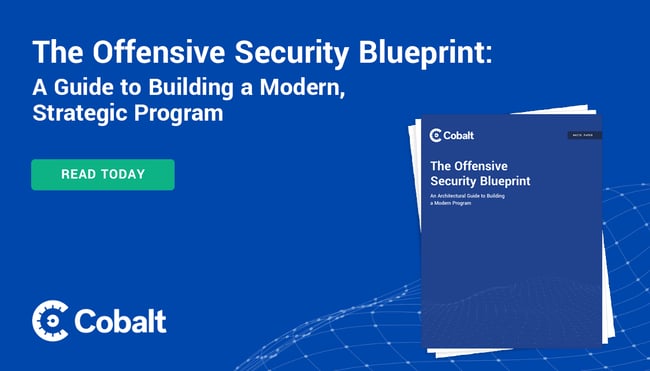Penetration testing as a service (PTaaS) provides a key component of an Offensive Security Testing Platform, giving you the ability to easily schedule on-demand probes of attack surface vulnerabilities and prioritize mitigations. Adding PTaaS to your arsenal empowers you to accelerate remediations, increase efficiency, and close skills gaps—thereby helping you harden your security posture, achieve compliance, and increase agility. Learn more about what penetration testing as a service is, how it benefits security teams and their brands, what a PTaaS platform includes, and what to look for when selecting one.
What Is PTaaS (Penetration Testing as a Service)?
Penetration testing as a service provides on-demand access to offensive security pentesting services from expert testers, making it easier to find and fix vulnerabilities across your digital environments. Pentesting proactively probes your attack surfaces for weaknesses, uncovers vulnerabilities, and prioritizes risks for remediation. PTaaS services use a cloud platform to launch pentests faster, collaborate in real time with professional testers, scan for vulnerabilities continuously during the testing process, and integrate your existing security tools into your remediation workflow.
PTaaS services help security teams solve the challenge of coordinating pentests in a timely manner, determining which vulnerabilities to prioritize, and managing remediations across the complex landscape of applications, networks, clouds, and infrastructures. Without using PTaaS, it can be burdensome to share findings, verify remediation implementations, fix recurring issues, and maintain security posture in real time.
By using a PTaaS platform, you can schedule pentests in as little as 24 hours, view findings and reports from a central interface, and manage your offensive security program efficiently. Aggregated findings reports help you triage vulnerabilities across all security tests and collaborate immediately on fixing priorities, even while tests are still being conducted. Real-time remediation is enabled by support from automated, continuous Dynamic Application Security Testing (DAST) and Attack Surface Management (ASM) scans and integrations with your existing tools. This improved efficiency makes it easier to allocate resources and budgets to plan annual pentest schedules.
Defining PTaaS: Beyond Traditional Pentesting
Pentesting a service differs from conventional pentests, which may be scheduled months in advance to test at a fixed point in time, use a rigid scope, rely on manual methods and siloed tools, and take longer to generate reports.
In contrast, PTaaS combines manual, human testing with a modern delivery platform to save time on procurement, deploy ongoing pentest programs with integrations, leverage ASM and DAST tools for continuous real-time testing, and facilitate ease of reporting. Combining traditional, manual penetration testing services with ASM and DAST unlocks a more efficient approach with continuous security testing. These benefits help account for why Gartner ranks PTaaS at the top of the Hype Cycle for Application Security in 2025.
The Core Philosophy: Continuous Security, On-Demand
Penetration testing as a service implements a core strategy of continuous security scheduled on-demand. With AI augmenting the ability of hackers to identify vulnerabilities, adapt offensive methods, and scale campaigns, conventional security and pentesting methods can no longer keep up with the speed of real-time attacks. Relying on slow, traditional pentests leaves you vulnerable to dangerous risks such as data breaches, ransomware, and LLM model poisoning.
PTaaS resolves these risks by providing the capability to schedule pentests on demand and scale quickly, to intercept attacks in real time, and implement fixes even before testing is completed. This gives your security team the edge you need to stay a step ahead of attackers relentlessly deploying continually changing attack methods.
Why PTaaS Is Reshaping Cybersecurity
The advantages of PTaaS represent a game-changer for cybersecurity, especially for organizations pursuing continuous threat exposure management (CTEM) to proactively mitigate vulnerabilities before attackers can exploit them. PTaaS offers faster insights and remediation, better efficiency at scale, and a way for organizations to close pentesting skills gaps.
Faster Insights, Quicker Remediation
Scheduling a conventional pentest typically takes weeks or longer, while fixing vulnerabilities after they’ve been found can take one to three months depending on the industry, Cobalt pentesting data shows. PTaaS cuts this down to as little as 24 hours for initial testing and seven days for retesting. This exponentially accelerates time to remediation, allowing security teams to implement fixes as soon as they’re discovered.
Cost-Effectiveness and Scalability
By enabling pentesting on demand, PTaaS makes testing scalable. This cuts costs by allowing teams to focus on priority attack surfaces and vulnerabilities, while making it easy to scale up and down as needed.
Bridging the Skills Gap
Many organizations lack the internal expertise to conduct pentests efficiently and accurately. PTaaS platforms close this skills gap by making it easy for teams to tap into specialized expertise from experienced pentesters without hiring new employees.
Key Features and Components of a Robust PTaaS Platform
A best-in-class pentesting as a service platform provides key features that are essential to realize fully the benefits of PTaaS. These include synthesis of human oversight with automated scanning, real-time analytics, workflow integrations, and expert support.
Automated Scanning with Human Oversight
Pentesting is ultimately a manual process, and human supervision is critical. At the same time, automated tools such as ASM and DAST can vastly increase the efficiency of human testers and the ability of teams to intercept attacks in real-time. An effective PTaaS platform needs to combine human oversight with automated scanning.
Real-time Reporting and Dashboards
For pentesting findings to be actionable, results need to be communicated to teams rapidly. A practical PTaaS platform needs to provide reports in real time, with data customized to reflect priorities and available to teams in user-friendly dashboards.
Integrated Remediation Workflows
Most security teams already have an established workflow using standard tools for project management, collaboration, ticketing, file exchange, development, and compliance management. To be efficient, a PTaaS platform should integrate with these workflows to simplify the process of scheduling tests, recommending remediations, and monitoring implementation.
Expert Consultation and Support
Pentesting depends on in-depth expertise in both the pentesting process and the infrastructure, platform, and software tools being tested. An effective PTaaS platform needs to enable organizations to tap into requisite expertise and receive expert support in a timely manner.
Who Benefits Most from PTaaS?
Penetration testing as a service can benefit any security team, but especially addresses the needs of several distinct types of users—particularly companies working toward a security maturity posture, organizations facing regulatory requirements, and teams with agile software development strategies.
Organizations with Maturing Security Programs
Organizations with mature security programs have moved beyond reactively responding to immediate threats and regulatory minimums and are proactively pursuing a continuously improving security posture that leverages automated tools and AI to achieve strategic goals supporting business objectives. PTaaS enables organizations to take security to the next level by implementing a risk-based approach to remediation and iteratively improving fortification of defenses.
Companies Facing Regulatory Compliance
Penetration testing as a service can alleviate pressure on companies that need to comply with industry-specific regulatory compliance requirements. Through PTaaS platforms, security teams can quickly connect with pentesters experienced with specific regulatory frameworks, rapidly schedule tests, implement and retest fixes, and meet regulatory deadlines on time and on budget.
Businesses with Agile Development Cycles
Best practices and regulatory pressure increasingly have prompted teams to implement a secure software development lifecycle (SSLC) methodology that builds security into every phase of design, development, and production rather than treating it as an add-on. Teams with agile development policies can benefit from integrating security into their software lifecycle to catch bugs early and save time and expenses by pre-empting late-stage fixes.
How Does PTaaS Compare to Traditional Pentesting?
Penetration testing as a service represents an advance on traditional pentesting for a variety of reasons. These include more frequent testing, better resource allocation, and greater operational efficiency.
Frequency and Scope: The Continuous Advantage
Traditional penetration testing often involves lengthy scoping, contracting, and reporting phases, with results reflecting a fixed point in time. PTaaS shortens the time it takes to set up a test while speeding up reporting and remediations, making it easier to continuously update security posture and adapt to ongoing threats.
Resource Allocation and Expertise
On-demand PTaaS makes it easier to allocate resources and expertise when scheduling pentests. Tests can be tailored to specific requirements and matched to corresponding expert talent at whatever scale is needed, saving time and money.
Operational Efficiency and ROI
The slowness of conventional pentesting creates operational friction that slows realization of benefits and impedes gains from investments. PTaaS optimizes resources, cutting time and costs and ensuring that tests and remediations focus on priority risks.
Getting Started with PTaaS: What to Look For
When selecting a penetration testing as a service platform, creating a checklist of critical criteria can help ensure a good fit for your needs. Key considerations include platform capabilities, pentester expertise,
Platform Capabilities and Integrations
To align your pentesting with practical security and business needs, your PTaaS platform should support integrations with your existing workflow, provide a historical view of testing data to track improvement, enable resting, and allow you to display results in customizable stakeholder-specific reports.
Provider's Expertise and Methodology
Your pentesting provider should offer access to a diverse range of expertise so you can match your specifications to tester qualifications. For example, the Cobalt Core pentesting community includes over 500 screened pentesters averaging 11 years of experience, representing the top 5% of all applicants.
Pricing Models and Scalability
Your PTaaS platform should use a pricing model that enables you to scale your testing to your required volume and budget. Cobalt facilitates a scalable, flexible consumption model with Cobalt credits: eight-hour units sold in annual packages that include asset scoping, retesting, and unlimited platform. This pricing model helps you plan and execute pentests on demand as needed.
To see how Cobalt’s PTaaS platform works and how it can serve your pentesting needs, contact our team to get a demo.
To learn more about how to build a modern security program that reduces risk, optimizes security spending, and accelerates innovation agility, download our Offensive Security Blueprint.







